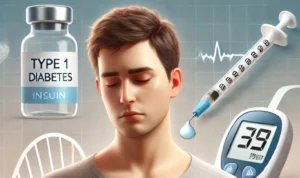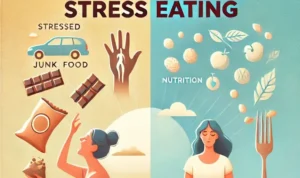Table of Contents
ToggleType 2 diabetes is a long‑term health condition that prevents your body from using sugar properly. In this clear, step‑by‑step guide, we break down medical terms into real‑life language. You’ll learn how sugar affects your cells, how to adjust meals and routines, and how to build habits around healthy eating, regular movement, and emotional well‑being. Each section gives simple actions and strategies you can use right away to feel stronger, more energetic, and in greater control of your lifestyle.
What Is Type 2 Diabetes?
Type 2 diabetes happens when your body cannot use insulin effectively, a hormone your pancreas produces after you eat. Over time, this leads to steadily high blood sugar, which can damage nerves, weaken blood vessels, and strain organs like your eyes, heart, and kidneys. It often develops gradually and may go unnoticed for years, starting in adulthood but sometimes affecting younger people too. That slow progression makes it treatable—understanding the condition early lets you build habits, set goals, and work with doctors to live a healthy, active life with fewer limits.
Also Read: Understanding Type 1 Diabetes
Key Signs of Type 2 Diabetes
- Increased thirst and dry mouth – High blood sugar prompts your kidneys to flush more sugar, leaving you constantly parched and rarely satisfied after drinking.
- Frequent urination – To remove all that excess sugar, you’ll visit the bathroom more often, even at night, disrupting sleep and energy levels.
- Unexplained weight loss – Without effective insulin, your body burns fat and muscle for fuel, leading to unintended weight changes even if you are eating normally.
- Persistent fatigue – Your cells lack the energy they need. Even restful sleep may not help, and your mind may feel foggy during daily tasks.
- Blurred vision – High sugar disrupts fluid levels in the lenses of your eyes, making vision fuzzy, and sometimes giving you headaches and trouble focusing.
Symptoms of Type 2 Diabetes
1. Increased Thirst
You experience ongoing, persistent thirst, and you often reach for drinks but never feel truly hydrated. Your body uses extra water to flush sugar from your system, making you feel constantly parched, even after several glasses.
2. Frequent Urination
You find yourself needing the bathroom more, even waking at night. Your kidneys are working overtime to remove sugar, leading to more frequent and sometimes urgent urges.
3. Extreme Hunger
After meals, your hunger returns quickly. This happens because your cells can’t absorb sugar without insulin, so they signal your brain that you need more fuel even after eating.
4. Sudden Weight Loss
You may lose weight without dieting. This occurs because your body burns stored fat and muscle tissue as energy when glucose can’t enter your cells, signaling a persistent energy shortage.
5. Slow Wound Healing
Even small cuts or scrapes stick around for days or weeks. High blood sugar weakens your immune response and slows tissue repair, making everyday care more critical.
6. Itchy Skin or Infections
You may notice recurring fungal or bacterial infections, especially on your feet or skin folds. Dry, itchy patches often appear because high sugar affects moisture balance and microbes on the skin.
7. Tingling or Numbness
You might experience pins-and-needles or numbness in your feet or fingertips. This nerve damage often starts lightly but may increase over time, affecting daily comfort and balance.
8. Blurred Vision
Frequent blood sugar swings distort the fluid balance inside your eyes. You may see changes in clarity, experience glare or halos around lights, or find near and far vision shifting.
9. Fatigue
You feel sluggish most days, even with enough sleep and rest. The root cause: your body’s inability to convert sugar into cellular energy consistently.
10. Gum Problems
Your gums may become red, tender, bleed during brushing, or develop pockets. Elevated blood sugar feeds harmful oral bacteria, increasing your risk of periodontal disease and tooth issues.
Causes of Type 2 Diabetes
1. Insulin Resistance
Your body starts ignoring insulin signals. The pancreas compensates by producing more insulin, but eventually, it cannot keep up, and blood sugar levels stay high—your cells literally stop listening to this critical hormonal message.
2. Genetic Factors
Family history counts. If close relatives have diabetes, your chance rises. However, lifestyle changes can break this genetic chain by supporting your own metabolic health and slowing disease progression.
3. Excess Weight
Carrying extra fat, especially centered around your abdomen, disrupts normal insulin function. This internal inflammation and stress on your metabolic system make it harder for insulin to do its job.
4. Physical Inactivity
If you sit for much of the day and avoid movement, your muscles become less responsive to insulin. Regular activity ensures muscles burn glucose and helps preserve long‑term insulin sensitivity.
5. Poor Diet
Eating lots of sugary drinks, white bread, fried food, and processed snacks can overwhelm your insulin system. Too many refined carbs cause spikes and crashes that gradually reduce your body’s ability to manage sugar effectively.
How Insulin Works
Insulin is a hormone your pancreas releases in response to rising blood sugar after meals. It acts like a key that unlocks doors on cell surfaces—especially in muscle, liver, and fat tissue—inviting glucose inside. Once inside, glucose provides energy for your brain, heart, muscles, and organs. After the entry, blood sugar levels naturally decline. Without enough insulin—or if cells ignore it—sugar stays in the bloodstream. That chronic high blood sugar damages blood vessels, nerves, and tissues throughout your body, which is why insulin function is so vital.
The Role of Glucose
Glucose, the key energy molecule in your blood, comes from foods rich in carbohydrates—like grains, fruits, starchy veggies, and sweets. Digestive enzymes break food into glucose, which enters your bloodstream within minutes of eating. As blood sugar rises, your pancreas releases insulin to guide glucose into your cells. Once inside, glucose generates energy for daily functions like movement, thinking, repairing, and healing. If glucose stays in the bloodstream, it disrupts body systems, weakens organs, and raises your risk of heart disease, nerve damage, vision issues, and other serious complications.
Risk Factors for Type 2 Diabetes
1. Being Overweight or Obese
Having excess body fat, especially around the abdomen, makes cells more resistant to insulin. This fat releases inflammatory signals that strain your insulin system and increase blood sugar.
2. Family History
If your parents or siblings have type 2 diabetes, your genetic risk is higher. Even with that inheritance, staying active and choosing healthy meals can lower the likelihood of developing it.
3. Age
Risk rises after age 45 due to natural metabolic shifts. But today, more younger adults and even teens develop type 2 diabetes, often linked to lifestyle trends and weight challenges.
4. Physical Inactivity
If your daily routine lacks movement, your muscles grow less sensitive to insulin. Even light exercise, like walking or stretching breaks, helps reduce that risk and strengthens your metabolic health.
5. Poor Diet
A diet high in sugar-sweetened beverages, desserts, and refined carbs overworks your insulin system. Frequent spikes strain insulin production and support fat gain, creating a harmful cycle.
6. High Blood Pressure or Cholesterol
These conditions often accompany type 2 diabetes. They both damage blood vessels, compound disease risk, and increase your chance of gout, heart attacks, strokes, and kidney problems.
7. Ethnicity
People of South Asian, Hispanic, African, or Indigenous background often have a higher diabetes risk. Cultural food choices and metabolic differences contribute—but coaching and lifestyle changes still help.
8. History of Gestational Diabetes
Women who had high blood sugar during pregnancy face a significantly higher risk later in life. Monitoring blood sugar and staying healthy postpartum can reduce long-term risk.
Complications from Type 2 Diabetes
- Heart disease and stroke – Chronic sugar levels damage arteries.
- Kidney damage (nephropathy) – High sugar harms renal filters, potentially causing dialysis.
- Nerve damage (neuropathy) – You may feel burning, tingling, or numbness worsening over time.
- Vision loss and eye problems – Retinopathy, cataracts, and glaucoma may arise.
- Foot problems and infections – Poor circulation and nerve issues cause ulcers and infection risk.
- Skin infections – Fungal and bacterial skin issues grow faster with high sugar.
- Dental issues – Gums swelling, pockets, and cavities rise due to sugar’s impact on mouth bacteria.
- Mental health challenges – Ongoing blood sugar swings, diet worries, and monitoring can heighten stress, anxiety, or depression beyond physical effects alone.
Managing Type 2 Diabetes
The Role of Diet
A smart diet is your most powerful tool. Choose whole, unprocessed foods—vegetables, whole grains, lean meats, fish, nuts, and healthy fats. Fiber helps stabilize sugar absorption, while low‑GI meals reduce spikes. Prepare meals in advance, stick to regular eating times, and skip sugary beverages, fried meals, and processed snacks. Eating this way supports better blood sugar control, helps you manage weight, improves mood, and boosts energy levels throughout the day.
Helpful for you: What to Eat to Lose Weight Fast
Sample Diet Plan
| Meal | Foods Recommended | Portion & Notes |
|---|---|---|
| Breakfast | Oatmeal with berries and sliced almonds | Loaded with fiber, healthy fats, and antioxidants |
| Mid-Morning | Plain Greek yogurt or one small apple | Offers protein or fiber help to stabilize blood sugar |
| Lunch | Grilled chicken salad with mixed greens | Balances lean protein, healthy fats, and nutrient-rich greens |
| Afternoon | Carrot sticks with hummus | Low‑GI snack that prevents afternoon dips and hunger |
| Dinner | Baked salmon, quinoa, and steamed broccoli | Rich in protein, omega‑3s, complex carbs, and vitamins |
| Evening | Cottage cheese or a handful of walnuts | Light protein snack to help stabilize overnight sugar |
Exercise for Type 2 Diabetes
- Brisk walking or jogging – Boosts insulin action and helps with weight management.
- Cycling or swimming – Gentle on joints and excellent for steady cardio.
- Resistance training – Build muscle to improve sugar uptake and metabolism.
- Yoga or Pilates – Enhances flexibility, reduces stress, and supports metabolic health.
- High‑Intensity Interval Training (HIIT) – Short, intense bursts followed by rest help burn fat and heighten insulin sensitivity quickly.
Can You Reverse Type 2 Diabetes?
1. Lose Weight
Even moderate weight loss (5–10%) significantly improves insulin effectiveness and lowers blood sugar, sometimes reversing early-stage diabetes.
2. Follow a Healthy Diet
Fill your meals with whole grains, colorful vegetables, lean protein, healthy fats, and minimal added sugar. This eating pattern supports better sugar control and overall health.
Helpful for you: Is Pasta Good for Weight Loss?
3. Exercise Regularly
Aim for at least 150 minutes of moderate aerobic exercise per week. Break this into 30-minute sessions most days—and mix in strength training twice weekly for best results.
4. Monitor Blood Sugar
Check your glucose levels at different times—before and after meals, and before bed. Use this information to fine-tune what and when you eat or exercise.
5. Work with Healthcare Providers
Stay connected to your doctor, diabetes educator, or online nutritionist for diabetes. They guide medication decisions, track progress, and help adjust your routines as your health improves.
Living with Type 2 Diabetes: Real‑Life Tips
- Check your blood sugar daily to track trends and prevent surprises.
- Plan meals weekly to avoid stress and impulsive eating choices.
- Cook at home as much as possible to control ingredients and portions.
- Carry healthy snacks like nuts, seeds, or fruit when on the go.
- Involve support from friends or family for accountability and encouragement.
- Join a support group or online community—connections reduce isolation and share tips.
- Schedule regular medical checkups to track A1C, kidney function, and heart health.
- Rotate injection or testing sites to avoid skin irritation and improve absorption.
- Practice stress management such as breathing, meditation, or yoga for emotional resilience.
- Aim for quality sleep—poor rest spikes blood sugar and lowers mood and focus.
When to Seek Professional Help
If you notice repeated high or low blood sugar readings, new vision problems, frequent wounds or infections, sudden unexplained fatigue, or mental health shifts, contact your healthcare provider immediately. For meal planning or dietary struggles, connect with an online nutritionist for diabetes. They provide personalized guidance, remote accountability, nutrition planning, and adjustments as your lifestyle and body change over time.
Conclusion
Type 2 diabetes doesn’t need to limit your life. With clear knowledge, steady habits, and the right support, you can manage—and sometimes reverse—it. This in-depth guide covers everything: what to watch for, how food and movement help, how to monitor progress, and when to seek professional care. Use these practical strategies today to feel stronger, healthier, and more empowered in every aspect of your daily routine.
Frequently Asked Questions
How common is Type 2 diabetes?
It accounts for over 90% of diabetes cases worldwide. Numbers rise due to increasing obesity, sedentary lifestyles, and changing diets, making it a major global health concern.
Is Type 2 diabetes genetic?
Yes. Genetics play a role. If your parents or siblings have it, your risk increases. But you control your fate: healthy foods, movement, and weight management can reduce that risk or delay onset.
What are the risk factors for Type 2 diabetes?
Top factors include obesity, physical inactivity, poor diet, older age, high blood pressure or cholesterol, family history, certain ethnicities, and gestational diabetes history—each contributing to metabolic strain over time.
How is Type 2 diabetes diagnosed?
Doctors use blood tests. These include fasting blood sugar, HbA1c (which shows average sugar over 2–3 months), and oral glucose tolerance tests. Repeat testing confirms a clear, accurate diagnosis.
What happens with Type 2 diabetes?
Your cells ignore insulin, leading to sugar buildup in your blood. That damages nerves, blood vessels, kidneys, eyes, and other organs. Over time, uncontrolled diabetes raises your risk of serious long‑term complications.
What foods should Type 2 diabetics avoid?
Avoid soda, juices with added sugar, candy, white bread, pastries, fried fast food, and processed snacks. Also, check hidden sugar in sauces, dressings, and packaged foods—these can spike your sugar without you noticing.
What is the best way to control Type 2 diabetes?
Balance a whole‑food diet, daily exercise, regular blood sugar checks, and weight loss if needed. Add medication when prescribed, reduce stress, sleep well, and maintain medical follow‑ups for long‑term control.
Is Type 2 diabetes life threatening?
Yes, if unmanaged. It raises risk of heart attack, stroke, kidney failure, vision loss, neuropathy, infections, and poor quality of life. But with proper care and lifestyle improvements, you can live long, healthy, disease‑managed years





